By Gabriel González Núñez
Gabriel González Núñez was born in Montevideo, Uruguay, and has lived in several countries, including Ecuador, Belgium, and the United States. His literary blog–which includes short stories, flash chronicles, and translations–can be accessed here. He lives in Brownsville, Texas, where he trains translators and interpreters at The University of Texas Rio Grande Valley. He is happily married and has, as of right now, two children.
Word has it that if you can speak English, Spanish, and Portuguese you can speak to the most members of the LDS Church. This reflects a demographic reality: the overwhelming majority of members of the Church live in the Americas. The most widely spoken language in the so-called New World is Spanish. Naturally, as membership grows in the Americas, the number of Spanish-speaking Latter-day Saints continues to grow. To me, this has meant for some time that there have to be Mormons in the Spanish-speaking world who write. And I’ve been trying to figure out who they are. Who we are, I should say, as Spanish is my native language and, I should add, the language of my heart (the two are not always the same).
As I searched, I discovered that indeed, Spanish-speaking Latter-day Saints are writing, some as a way to make a living and others because they have something positive to say. For this post, however, I will focus on writers who have published books that are literary in nature. I will survey a number of authors who are LDS and who have published either poetry, plays, short stories, or novels. I also will focus on contemporary writers, as my search did not really extend into past generations. Notice that the emphasis is on Mormon writers and not necessarily Mormon literature. That’s because, as readers will see, we can’t really speak of a Mormon literature in Spanish. Not yet at least. So literature by Mormons will have to do at this point. Even so, when I discuss these writers, I will make sure to point out any Mormon themes in their writing.
Before listing the authors, it should be clear the following is an incomplete list. If one considers the places where the Church is strongest, there have to be some Mormon authors in, say, Chile, a land of poets. If one considers places with rich literary traditions, there have to be Mormon authors in places like Colombia, and perhaps even Spain (Spain is tricky because it has a literary tradition that dates back to medieval times but a very tiny LDS population). In my searching, however, I seem to have found only three or four places that produce Mormon writers. The first is Argentina. This country has long produced excellent writers, and given the Church’s relative strength in the Southern Cone, it’s not surprising that a number of writers would be found there. So I will begin there:
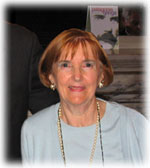 Iris Myfanwy Lloyd was born in the Argentine province of Chubut, an area which was colonized by Welsh immigrants in the mid-1800s. She herself is a descendant of the very first settlers, and this connection to the early colonists in her native Patagonia may be what inspired her in 2004 to self-publish Patagonia gringa [Patagonia of European Immigrants]. The book is now out of print, and despite
Iris Myfanwy Lloyd was born in the Argentine province of Chubut, an area which was colonized by Welsh immigrants in the mid-1800s. She herself is a descendant of the very first settlers, and this connection to the early colonists in her native Patagonia may be what inspired her in 2004 to self-publish Patagonia gringa [Patagonia of European Immigrants]. The book is now out of print, and despite 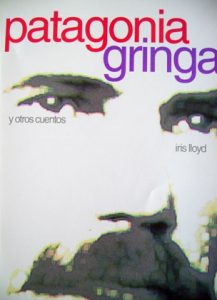 several attempts to obtain a copy, I have been unable to do so. Consequently, I can’t comment on whether it has any Mormon content. According to this review, the work is a collection of poetry, short stories, and personal narratives that celebrate Patagonia’s legacy and culture. At least one of the book’s stories, a historical piece titled “Carmen,” has found its way online here. The book gave Lloyd some level of recognition in Patagonia’s cultural and literary scene, and she received the Eisteddfod Mimosa award in 2008 for one of her poems. I have not been able to track down any other published works from Lloyd, and given her advanced age and frail state, it is unlikely she will publish anything new.
several attempts to obtain a copy, I have been unable to do so. Consequently, I can’t comment on whether it has any Mormon content. According to this review, the work is a collection of poetry, short stories, and personal narratives that celebrate Patagonia’s legacy and culture. At least one of the book’s stories, a historical piece titled “Carmen,” has found its way online here. The book gave Lloyd some level of recognition in Patagonia’s cultural and literary scene, and she received the Eisteddfod Mimosa award in 2008 for one of her poems. I have not been able to track down any other published works from Lloyd, and given her advanced age and frail state, it is unlikely she will publish anything new.
 Another Argentine author is Guillermo Italia. He’s published a number of short stories since 1999, including one that has been included in a Chilean school textbook. He is a teacher in Chubut’s school system, and perhaps this is why his short stories are highly pedagogical. Their content is clearly didactic, intended at least in part to compliment classroom instruction. For some time now, Italia has been posting his stories on his Facebook profile. Based on the stories I’ve read, there’s nothing distinctly Mormon about them. In 2007 he also published a novel, Dos soles [Two Suns], a copy of which I haven’t yet been able to secure.
Another Argentine author is Guillermo Italia. He’s published a number of short stories since 1999, including one that has been included in a Chilean school textbook. He is a teacher in Chubut’s school system, and perhaps this is why his short stories are highly pedagogical. Their content is clearly didactic, intended at least in part to compliment classroom instruction. For some time now, Italia has been posting his stories on his Facebook profile. Based on the stories I’ve read, there’s nothing distinctly Mormon about them. In 2007 he also published a novel, Dos soles [Two Suns], a copy of which I haven’t yet been able to secure.
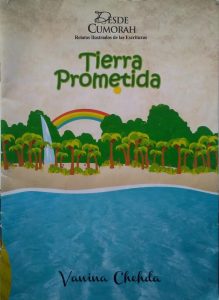 Also out of Argentina comes the only Mormon author I’ve been able to find who has published children’s literature. Vanina Chehda self-published a children’s
Also out of Argentina comes the only Mormon author I’ve been able to find who has published children’s literature. Vanina Chehda self-published a children’s  book in 2015 titled Tierra prometida [Promised Land] along with a companion coloring book that bears the same name. The story book is a retelling of the events found in 1st and 2nd Nephi. Notably, the story is a first-person narration from Sariah’s point of view, peppered with scriptural passages. Thus, it brings a feminine perspective into a rather male-oriented story. The story book also includes some discussion questions and a glossary. Chedha is a graphic designer, so she wrote and illustrated both books herself.
book in 2015 titled Tierra prometida [Promised Land] along with a companion coloring book that bears the same name. The story book is a retelling of the events found in 1st and 2nd Nephi. Notably, the story is a first-person narration from Sariah’s point of view, peppered with scriptural passages. Thus, it brings a feminine perspective into a rather male-oriented story. The story book also includes some discussion questions and a glossary. Chedha is a graphic designer, so she wrote and illustrated both books herself.
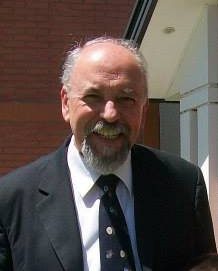 No survey of current Argentine authors can be concluded without mentioning Mario R. Montani. He published a short story collection in 2009 titled El castillo gris y otros cuentos [The Grey Castle and Other Stories] (Editorial Dunken), which contains no distinctive Mormon features. However, where he has done a lot of interesting work in terms of Mormon literature is his own blog Mormonsofía. The blog offers writings on Mormon cinema, theater, literature, music, science, doctrine, and so forth from a peripheral position. In terms of literature, he’s published about and translated the works of English-language Mormon authors, but he also envisions
No survey of current Argentine authors can be concluded without mentioning Mario R. Montani. He published a short story collection in 2009 titled El castillo gris y otros cuentos [The Grey Castle and Other Stories] (Editorial Dunken), which contains no distinctive Mormon features. However, where he has done a lot of interesting work in terms of Mormon literature is his own blog Mormonsofía. The blog offers writings on Mormon cinema, theater, literature, music, science, doctrine, and so forth from a peripheral position. In terms of literature, he’s published about and translated the works of English-language Mormon authors, but he also envisions 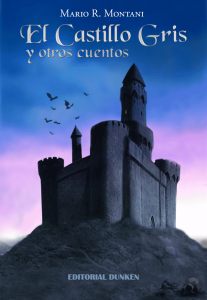 his blog as a place to help Spanish-language Mormon letters grow. To that end, he’s transcribed the poetry of Máximo Corte, a now largely forgotten early Mormon poet in Argentina who regularly contributed pieces to El Mensajero Deseret in the 30s and 40s. He’s also published his own Mormon fiction, which includes three pieces of flash fiction, a romance about a Great Supper, a poem about Zarahemla’s fall, and the entire Doctrine and Covenants condensed into a set of haikus. Montani believes that Spanish-speaking members of the Church have important, non-US perspectives to offer through literature, and his own creative writing is an example of that.
his blog as a place to help Spanish-language Mormon letters grow. To that end, he’s transcribed the poetry of Máximo Corte, a now largely forgotten early Mormon poet in Argentina who regularly contributed pieces to El Mensajero Deseret in the 30s and 40s. He’s also published his own Mormon fiction, which includes three pieces of flash fiction, a romance about a Great Supper, a poem about Zarahemla’s fall, and the entire Doctrine and Covenants condensed into a set of haikus. Montani believes that Spanish-speaking members of the Church have important, non-US perspectives to offer through literature, and his own creative writing is an example of that.
This article will be continued in Part II, where authors from Mexico, Uruguay, and elsewhere will be surveyed, and some concluding thoughts will be presented.

I am so excited to hear more on this subject. Hopefully readers will add more authors to this list.
Here are some things I am aware of:
There was a GRETA Hispanic Theatre (Grupo Experimental de Teatro Americas) in Salt Lake City in the late 1990s and early 2000s, which performed original works in Spanish. http://universe.byu.edu/1997/02/13/spanishspeaking-theater-group-comes-to-utah/
Alfredo and Alejandro Laguna were the directors. “GRETA, an acronym for Grupo Experimental de Teatro Americas, is an independent theater company with 25 actors and actresses, said Alejandro Laguna, GRETA’s director. Most of the cast members are from Salt Lake City but some are from Ecuador and Peru. They joined together to “teach people to know theater,” Alejandro said.” Among their plays were: “Las Danzas de la Muerte,” [The Dances of Death], “Los Santos y sus Suenos”, and “El Leon Pelon”.
Kent Larsen wrote several posts about the potential of Mormon publishing in Spanish and Portuguese markets.
http://www.motleyvision.org/2005/publishing-english-only/
http://www.motleyvision.org/2008/could-the-us-support-a-spanish-language-lds-market-alone/
http://www.motleyvision.org/2008/help-me-find-the-non-american-mormon-culture/
http://www.motleyvision.org/2010/la-piedra-ente-la-neve/
There was a publisher called Aztec Press (Previously Latin Voice and Libreria Voz Latina SUD), run by Sonia Pineda, in West Jordan, UT. They appear to only have published non-fiction works. She mentioned two authors of Spanish language material, Luis E. Zegarra and Hans Caspary.
Andrew, I read the links you provided and found to be quite interesting. It would seem there might be a market, but it’s hard to reach because it’s so diffused (it’s a loooong ways from Patagonia to central Utah).
It seems also like attempts to have Spanish- or Portuguese-language publishers in the past have failed. Aztec Press (Spanish non-fiction) went under. Samuel Lamanite Editions (Portuguese fiction) also went under.
So it would seem like a small, one-language press specializing in only fiction or non-fiction wouldn’t work.
Consequently, it seems like the successful publishing model might be a larger press with a Spanish-and-Portuguese-language imprint that does both fiction and non-fiction. Does that sound about right?
.
What an exciting post! I would love to read translations of some of this stuff. Hopefully, someday, that will be possible.
Mario R. Montani’s website is quite the Mormon Literature site. He wrote a bunch of detailed introductions to authors like Orson Scott Card, Raymond Jones, Shannon Hale, Ina Coolbrith (and translated several of her poems), Carol Lynn Pearson, Emma Lou Thayne, etc.
https://mormosofia.wordpress.com/…/escritores-mormones/
Then he also translated three short stories from Dialogue: a journal of Mormon thought, by Roger Terry, Ryan Shoemaker, and Hugo Olaiz (who is himself Argentinian).
https://mormosofia.wordpress.com/…/lit…/ficcion-mormona/
After I wrote this post, Mario Montani reached out to me to point out I had missed Cristalina Roca, an Argentine author of children’s literature. I contacted her, and I can provide the following information:
Cristalina Roca has been publishing with Editorial Dunken for nearly a decade. She has published the following books for children and/or young adults: La bruja azul [The Blue Witch] (2008), Todo tú [All You] (2008), La cortina de energía [The Energy Curtain] (2009), De hadas y brujas [Of Faries and Witches] (2010), La escuela para príncipes [The School for Princes] (2011), and Claudia y los duendes (de Bs. As.) [Claudia and the (Buenos Aires) Goblins] (2012). In the story book La escuela para príncipes the Prince who founded the school indicates he was inspired to do so by an ancient king whose name was Benjamin and who was concerned about his children. She is referring to the Book of Mormon’s King Benjamin. She has also published two collections of short speculative/fantasy fiction for adults, namely La edad de… Lúcida, Libriana, Marcix y G. y R. [The Age of… Lúcida, Libriana, Marcix, and G. y R.] in 2014 and Dinero [Money] in 2017.